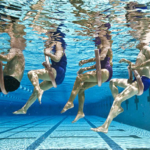Early AFO use significantly enhances benefits of stroke rehabilitation
Functional balance test scores rise.
Use of an ankle foot orthosis (AFO) within six weeks of stroke results in better balance outcomes and earlier independent ambulation than if AFO use is delayed, according to research from the Netherlands.
The SAFO (silicone ankle foot orthosis) is a skin-friendly, custom-fabricated silicone orthosis. As a supplement to orthotic fittings, users with foot drop can wear the SAFO without a shoe at home, in wet areas and even when swimming.
By Jordana Bieze Foster, Lower Extremity Review March 2013
Investigators from Roessingh Research & Development in Enschede randomized 18 patients to receive AFOs at either the time of inclusion in the study (within six weeks of stroke) or eight weeks later. Both groups received the same rehabilitation, with a focus on balance and ambulation, the only difference being that the “late” group did the first eight weeks of rehabilitation without an AFO while the “early” group did all rehabilitation while wearing AFOs. Balance measures were assessed every two weeks for 16 weeks.
AFOs were prefabricated non-articulated devices made from polypropylene in three different rigidities to accommodate a range of patient needs. Device fitting involved particular attention to the alignment of the AFO within the shoe and the alignment of the knee and hip, said Jaap Buurke PT PhD, scientific manager of the research cluster Restoration and Human Function at Roessingh Research & Development, who presented his group’s findings at the ISPO World Congress in Hyderabad on behalf of graduate student Corien Nikamp.
At follow up, both groups demonstrated significant improvement on the Berg Balance Scale and Functional Ambulation Categories balance tests, but improvements in the early AFO group were more pronounced and occurred earlier than in the late group. Early AFO users achieved independent ambulation earlier than those in the late group, and there was a trend toward better outcomes on the 10-m walk test, six-minute walk test, and Timed Up and Go test for the early group.
Previous research from the same Dutch institution suggests that improvement on functional balance tests with AFO use is not necessarily reflected in instrumented tests of dynamic balance. In a 2009 study published in Clinical Biomechanics, Buurke and colleagues found that 20 chronic stroke patients performed significantly better with AFOs than without on five functional balance tests but not on platform-based force plate tests of dynamic balance.
The current study addresses some limitations of the earlier one, Buurke said.
“In a cross-sectional study, the patients are almost always chronic stroke patients and the intervention often involves not providing the AFO but removing it,” he said.
In a separate study presented in Hyderabad, researchers from the University of Strathclyde in Glasgow, Scotland, used 3D motion analysis to assess the effect of polypropylene solid AFOs on gait mechanics in three patients, beginning within two months from stroke onset and continuing for six months.
Stephanos Solomonidis BSc CEng FIMechE, senior lecturer in biomedical engineering at the university, and colleagues found that the AFOs improved joint kinematics in both the paretic and sound limbs, facilitated heel strike, and reduced toe drag during swing. In addition, one patient was analyzed wearing an instrumented AFO, which confirmed that the device reduced the net ankle moment by assisting the dorsiflexor muscles during the first half of stance phase.
Source Lower Extremity Review
| References |
evolutions_poster_dutch_congress_of_rehabilitation_medicine_2013
Timing of ankle foot orthoses after stroke: First results of a randomized longitudinal study, Nikamp C, Buurke J, Nederhand M, et al. Presented at International Society of Prosthetics and Orthotics 2013 World Congress, Hyderabad, India, February 2013.
Ankle-foot orthoses in stroke: Effects on functional balance, weight-bearing asymmetry and the contribution of each lower limb to balance control, Simons CD, van Asseldonk EH, van der Kooij H, et al. Clin Biomech 2009;24(9):769-775.
Effect of ankle foot orthoses on gait biomechanics of early stroke patients, Papi E, Solomonidis S, Bowers R, Rowe P. Presented at International Society of Prosthetics and Orthotics 2013 World Congress, Hyderabad, India, February 2013.
| Further reading |
Foot drop stimulation versus ankle foot orthosis after stroke: 30-week outcomes, Kluding PM, Dunning K, O’Dell MW, Wu SS, Ginosian J, Feld J, McBride K. Stroke. 2013 Jun;44(6):1660-9. doi: 10.1161/STROKEAHA.111.000334. Epub 2013 May 2.
Long-Term Follow-up to a Randomized Controlled Trial Comparing Peroneal Nerve Functional Electrical Stimulation to an Ankle Foot Orthosis for Patients With Chronic Stroke, Bethoux F, Rogers HL, Nolan KJ, Abrams GM, Annaswamy T, Brandstater M, Browne B, Burnfield JM, Feng W, Freed MJ, Geis C, Greenberg J, Gudesblatt M, Ikramuddin F, Jayaraman A, Kautz SA, Lutsep HL, Madhavan S, Meilahn J, Pease WS, Rao N, Seetharama S, Sethi P, Turk MA, Wallis RA, Kufta C. Neurorehabil Neural Repair. 2015 Nov-Dec;29(10):911-22. doi: 10.1177/1545968315570325. Epub 2015 Feb 4.
Also see
Stroke: The evidence for orthotic treatment Lower Extremity Review






